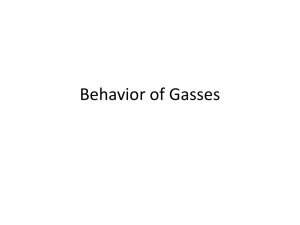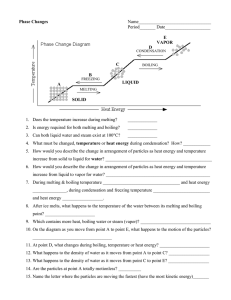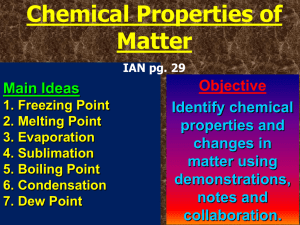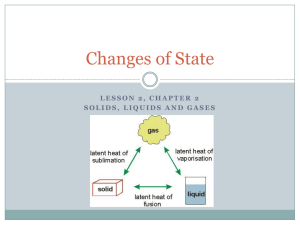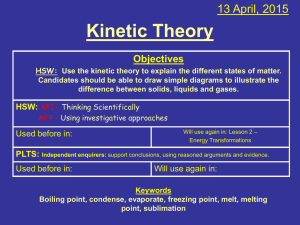Changes of State
advertisement
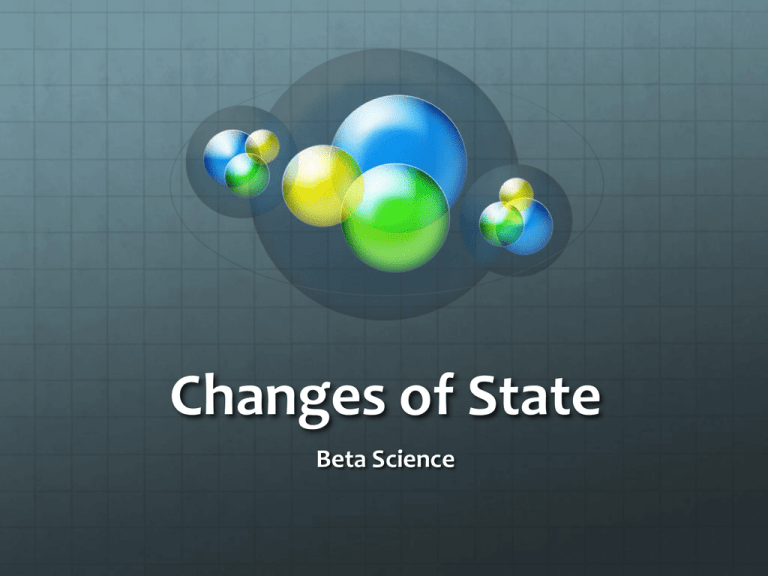
Changes of State Beta Science Overview This PowerPoint examines how matter changes from state to state. Changes in state are explained in terms of matter gaining or losing energy. Change of State Change of state: The change of a substance from one physical state to another. All changes of state are PHYSICAL CHANGES. Therefore, the “identity” of a substance does not change. Particles of a substance move differently depending on the state of the substance. Particles have different amounts of energy when the substance is in different states. Therefore, in order to change substances from one state to another, you must add or remove energy. * Adding and Subtracting Energy Endothermic: when energy is added to a substance as it changes state. Means the object was heated-up Exothermic: when energy is removed from the substance as it changes state. Means the object was cooled down Melting Melting: the change of state in which a solid becomes a liquid by adding energy. Adding energy to a substance increases the temperature of a substance As temperature increases the particles begin to move faster. As soon as a solid hits a certain amount of energy the solid will melt. Melting Point: the temperature at which a substance changes from a solid to a liquid. Different substances have different melting points. Gallium melts at 30°C. Normal body temp is 37°C. Therefore, Gallium will melt in your hand. Table Salt has a melting point of 801°C so it will not melt in your hand. Freezing Freezing: the change of state from a liquid to a solid. Freezing point: the temperature at which a liquid changes from a liquid to a solid. Different substances have different freezing points. Freezing and melting occur at the same temperature. Ex. Liquid water freezes at the same temperature at which ice melts- 0°C Evaporation Evaporation: the change of a substance from a liquid to a gas. Can occur at the surface of a liquid that is below it’s boiling point. Ex. When you sweat your body is cooled through evaporation. Water absorbs energy from your skin as it evaporates. You feel cooler because your body transfers energy to the water. Boiling Boiling: The change of a liquid to a vapor or gas throughout the liquid. Vapor Pressure: pressure inside bubbles of boiling water. Atmospheric pressure: pressure from the outside of the bubbles. Boiling occurs when the vapor pressure equals the atmospheric pressure. Boiling Point: The temperature at which a liquid boils. Ex. Water boils at 100°C Pressure and Boiling Did you know: water only boils at 100°C at sea level? In Denver, water boils at 95°C. Atmospheric pressure varies depending on where you are in relation to sea level. Atmospheric pressure is lower at higher elevations. If you were to boil water on top of a mountain, the boiling point would be lower than 100°C. Why? A: because vapor pressure and atmospheric pressure have to be the same in order for water to boil. Condensation Condensation: the change of state from a gas to a liquid. Condensation is the reverse of evaporation. Condensation Point: the temperature at which a gas becomes a liquid. The condensation point is the same temperature as the boiling point at a given pressure. How Condensation Occurs In order for a gas to become a liquid, large numbers of particles must clump together. First they must have a strong enough attraction to one another to overcome their current traveling path. For this to happen energy is removed from the gas to slow the movement of the particles. Because energy is removed in the condensation process, it is an exothermic change. Sublimation Sublimation: the process in which a solid changes into a gas. Ex. Dry ice For this to happen, particles must move from being tightly packed to being spread far apart. Attractions must be completely overcome. Particles must gain energy to overcome the attractions Sublimation, therefore, is an endothermic change. Change of Temperature vs Change of State In order to lose or gain energy, a substance must either change temperature or change state. Temperature speeds up particles to help them overcome attraction. But the temperature does not change until the change of state is complete. Ex. The temperature of boiling water stays at 100°C until it has all evaporated.
